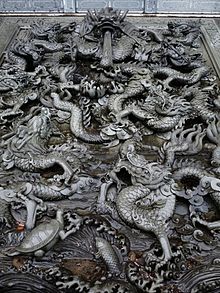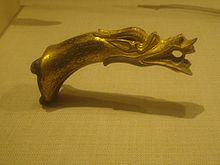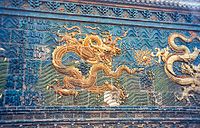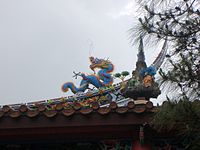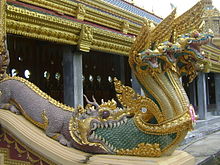- Chinese dragon
-
Chinese dragon 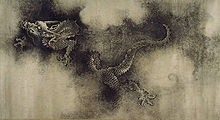
Chinese name Traditional Chinese 龍 Simplified Chinese 龙 Hanyu Pinyin lóng Transcriptions Gan - Romanization liūng Mandarin - Hanyu Pinyin lóng Min - Hokkien POJ lêng, liông Cantonese (Yue) - Yale Romanization lùhng Japanese name Hiragana 1. りゅう
2. たつKyūjitai 龍 Shinjitai 竜 Transcriptions - Revised Hepburn 1. ryū
2. tatsu- Kunrei-shiki 1. ryû
2. tatuKorean name Hangul 1. 룡/용
2. 미르 Pure KoreanHanja 龍 Transcriptions - Revised
Romanization1. ryong/yong
2. mirVietnamese name Quốc ngữ rồng, long Hán tự 龍 Chinese dragons are legendary creatures in Chinese mythology and folklore, with mythic counterparts among Japanese, Korean, Vietnamese, Bhutanese, Western and Turkic dragons. In Chinese art, dragons are typically portrayed as long, scaled, serpentine creatures with four legs. In yin and yang terminology, a dragon is yang and complements a yin fenghuang ("Chinese phoenix").
In contrast to European dragons, which are considered evil, Chinese dragons traditionally symbolize potent and auspicious powers, particularly control over water, rainfall, hurricane, and floods. The dragon is also a symbol of power, strength, and good luck. With this, the Emperor of China usually uses the dragon as a symbol of his imperial power.
In Chinese daily language, excellent and outstanding people are compared to the dragon while incapable people with no achievements are compared with other, disesteemed creatures, such as the worm. A number of Chinese proverbs and idioms feature references to the dragon, for example: "Hoping one's son will become a dragon" (望子成龍, i.e. be as a dragon).
Contents
Symbolic value
Historically, the dragon was the symbol of the Emperor of China. In the Zhou Dynasty, the 5-clawed dragon was assigned to the Son of Heaven, the 4-clawed dragon to the nobles (zhuhou, seigneur), and the 3-clawed dragon to the ministers (daifu). In the Qin Dynasty, the 5-clawed dragon was assigned to represent the Emperor while the 4-clawed and 3-clawed dragons were assigned to the commoners. The dragon in the Qin Dynasty appeared on national flags.[1]
The dragon is sometimes used in the West as a national emblem of China. However, this usage within both the People's Republic of China and the Republic of China on Taiwan as the symbol of nation is not common. Instead, it is generally used as the symbol of culture. In Hong Kong, the dragon is part of the design of Brand Hong Kong, a symbol used to promote Hong Kong as an international brand name.[2]
In European-influenced cultures, the dragon has aggressive, warlike connotations and it is conjectured that the Chinese government wishes to avoid using it as a symbol, but most Chinese disagree with this decision.[3] Westerners only sometimes confuse the disposition of the benevolent Chinese dragon with the aggressive Western dragon.
Sometimes Chinese people use the term "Descendants of the Dragon" (simplified Chinese: 龙的传人; traditional Chinese: 龍的傳人; pinyin: lóng de chuán rén) as a sign of ethnic identity, as part of a trend started in the 1970s when different Asian nationalities were looking for animal symbols for representations.[1] The wolf was used among the Mongols, the monkey among Tibetans.[1]
In Chinese culture today, the dragon is mostly used for decorative purposes. It is a taboo to disfigure a depiction of a dragon; for example, an advertisement campaign commissioned by Nike, which featured the American basketball player LeBron James slaying a dragon (as well as beating up an old Kung Fu master), was immediately banned by the Chinese government after public outcry over disrespect.[4]
Regional variations across Asia
While depictions of the dragon in art and literature are largely consistent throughout the cultures in which it is found, there are some regional differences. The remainder of this article deals with aspects common across cultures, as well as features peculiar to cultural China.
For more information on peculiarities in the depiction of the dragon in other Asian cultures, see:
- Druk, the Thunder Dragon of Bhutanese mythology
- Japanese dragon
- Korean dragon
- Nāga (or Naga), a Hindu or Buddhist deity often depicted as a king cobra
- Vietnamese dragon
- Nepalese dragon as depicted with Bahirav
Dragon worship
Origin
 The C-shaped jade totem of Hongshan Culture
The C-shaped jade totem of Hongshan Culture Gilded-bronze handle in the shape of a dragon's head and neck, made during the Eastern Han period (25–220 AD)
Gilded-bronze handle in the shape of a dragon's head and neck, made during the Eastern Han period (25–220 AD)
The origin of the Chinese dragon is not certain. The presence of dragon in Chinese culture can dates back several thousands of years with the discovery of a dragon statue dating back to the fifth millennium BC from the Yangshao culture in Henan in 1987,[5] and jade badges of rank in coiled form have been excavated from the Hongshan culture circa 4700-2900 BC.[6]
The coiled snake or dragon form played an important role in early Chinese culture. The character for "dragon" in the earliest Chinese writing has a similar coiled form, as do later jade dragon amulets from the Shang period.[7]
Ancient Chinese referred to unearthed dinosaur bones as dragon bones and documented them as such. For example, Chang Qu in 300 BC documents the discovery of "dragon bones" in Sichuan.[8] The modern Chinese word for dinosaur is konglong (恐龍, meaning "terrible dragon"), and villagers in central China have long unearthed fossilized "dragon bones" for use in traditional medicines, a practice that continues today.[9]
The binomial name for a variety of dinosaur discovered in China, Mei long, in Chinese (寐 mèi and 龙 lóng) means "sleeping dragon." Fossilized remains of Mei long have been found in China in a sleeping and coiled form, with the dinosaur nestling its snout beneath one of its forelimbs while encircling its tail around its entire body.[10]
Some have further suggested that the Chinese dragon form comes from stylized depictions of existing animals, such as snakes, fish, or crocodiles. A view advocated by He Xin is that the early dragon depicted a species of crocodile, specifically, Crocodylus porosus, the saltwater crocodile, which is the largest living reptile, and once ranged into China during ancient times. The crocodile is known to be able to accurately sense changes in air pressure, and be able to sense coming rain. This may have been the origin of the dragon's mythical attributes in controlling the weather, especially the rain. The association with the crocodile is also supported by the view in ancient times that large crocodiles are a variety of dragon. For example, in the Story of Zhou Chu, about the life of a Jin Dynasty warrior, he is said to have killed a "dragon" that infested the waters of his home village, which appears to have been a crocodile.
Some scholars believe that the Chinese dragon form originated from totems of different tribes in China, as a merger of totems of various tribes consequential to tribal mergers. Legendary figures like Nüwa (女媧) and Fuxi (伏羲) are depicted as having snake bodies. Some scholars have noted that a myth arose that the first legendary Emperor of China, Huangdi (黃帝, Yellow Emperor) used a snake for his coat of arms. According to the myth, every time he conquered another tribe, he incorporated his defeated enemy's emblem into his own, thus explains why the dragon appears to have features of various animals.
Mythical creature
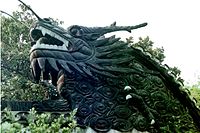 Non-Imperial Chinese dragon in Shanghai
Non-Imperial Chinese dragon in Shanghai
From its origins as totems or the stylized depiction of natural creatures, the Chinese dragon evolved to become a mythical animal. The Han Dynasty scholar Wang Fu recorded Chinese myths that long dragons had nine anatomical resemblances.
The people paint the dragon's shape with a horse's head and a snake's tail. Further, there are expressions as 'three joints' and 'nine resemblances' (of the dragon), to wit: from head to shoulder, from shoulder to breast, from breast to tail. These are the joints; as to the nine resemblances, they are the following: his horns resemble those of a stag, his head that of a camel, his eyes those of a demon, his neck that of a snake, his belly that of a clam (shen, 蜃), his scales those of a carp, his claws those of an eagle, his soles those of a tiger, his ears those of a cow. Upon his head he has a thing like a broad eminence (a big lump), called [chimu] (尺木). If a dragon has no [chimu], he cannot ascend to the sky.[11]
Further sources give variant lists of the nine animal resemblances. Sinologist Henri Doré lists these characteristics of an authentic dragon: "The horns of a deer. The head of a camel. A demon's eyes. The neck of a snake. A tortoise's viscera. A hawk's claws. The palms of a tiger. A cow's ears. And it hears through its horns, its ears being deprived of all power of hearing."[12] He notes that, "Others state it has a rabbit's eyes, a frog's belly, a carp's scales." The anatomy of other legendary creatures, including the chimera and manticore, is similarly amalgamated from fierce animals.
Chinese dragons were considered to be physically concise. Of the 117 scales, 81 are of the yang essence (positive) while 36 are of the yin essence (negative). Initially, the dragon was benevolent but the Buddhists introduced the concept of malevolent influence among some dragons. Just as water destroys, they said, so can some dragons destroy via floods, tidal waves and storms. They suggested that some of the worst floods were believed to have been the result of a mortal upsetting a dragon.
Many pictures of oriental dragons show a flaming pearl under their chin. The pearl is associated with wealth, good luck, and prosperity.
Chinese dragons are occasionally depicted with bat-like wings growing out of the front limbs, but most do not have wings, as their ability to fly (and control rain/water, etc.) are mystical and not seen as a result of their physical attributes.
This description accords with the artistic depictions of the dragon down to the present day. The dragon has also acquired an almost unlimited range of supernatural powers. It is said to be able to disguise itself as a silkworm, or become as large as our entire universe. It can fly among the clouds or hide in water (according to the Guanzi). It can form clouds, can turn into water, can change color as an ability to blend in with their surroundings, as an effective form of camouflage or glow in the dark (according to the Shuowen Jiezi).
In Singapore and many other countries, folktales speak of the dragon having all the attributes of the other 11 creatures of the zodiac, this includes the whiskers of the rat, the face and horns of an ox, claws and teeth of a tiger, belly of a rabbit, body of a snake, legs of a horse, the beard of a goat, wit(or brain) of a monkey, crest of a rooster, ears of a dog, the snout of a pig.
In some circles, it is considered bad luck to depict a dragon facing downwards, as it is seen as disrespectful to place a dragon in such manner that it cannot ascend to the sky. Also, depictions of dragons in tattoos are prevailent as they are symbols of strength and power, especially criminal organisations where dragons hold a meaning all on their own. As such, it is believed that one must be fierce and strong enough, hence earning the right to wear the dragon on his skin, lest his luck be consumed by the dragon.
Ruler of weather and water
Main article: Dragon King A dragon seen floating among clouds, on a golden canteen made during the 15th century, Ming Dynasty
A dragon seen floating among clouds, on a golden canteen made during the 15th century, Ming Dynasty
Chinese dragons are strongly associated with water in popular belief. They are believed to be the rulers of moving bodies of water, such as waterfalls, rivers, or seas. They can show themselves as water spouts (tornado or twister over water). In this capacity as the rulers of water and weather, the dragon is more anthropomorphic in form, often depicted as a humanoid, dressed in a king's costume, but with a dragon head wearing a king's headdress.
There are four major Dragon Kings, representing each of the four seas: the East Sea (corresponding to the East China Sea), the South Sea (corresponding to the South China Sea), the West Sea (sometimes seen as the Indian Ocean and beyond), and the North Sea (sometimes seen as Lake Baikal).
Because of this association, they are seen as "in charge" of water-related weather phenomenon. In premodern times, many Chinese villages (especially those close to rivers and seas) had temples dedicated to their local "dragon king". In times of drought or flooding, it was customary for the local gentry and government officials to lead the community in offering sacrifices and conducting other religious rites to appease the dragon, either to ask for rain or a cessation thereof.
The King of Wu-Yue in the Five Dynasties and Ten Kingdoms period was often known as the "Dragon King" or the "Sea Dragon King" because of his extensive hydro-engineering schemes which "tamed" the sea.
Symbol of imperial authority
An imperial robe from the Qing Dynasty
According to Chinese legend, both Chinese primogenitors, the earliest Emperors, Yandi and Huangdi, were closely related to 'Long' (Chinese Dragon). At the end of his reign, the first legendary Emperor, Huangdi, was said to have been immortalized into a dragon that resembled his emblem, and ascended to Heaven. The other legendary Emperor, Huangdi's brother, Yandi was born by his mother's telepathy with a mythic dragon. Since the Chinese consider Huangdi and Yandi as their ancestors, they sometimes refer to themselves as "the descendants of the dragon". This legend also contributed towards the use of the Chinese dragon as a symbol of imperial power.
The dragon, especially yellow or golden dragons with five claws on each foot, was a symbol for the emperor in many Chinese dynasties. The imperial throne was called the Dragon Throne. During the late Qing Dynasty, the dragon was even adopted as the national flag. The dragon is featured in the carvings on the steps of imperial palaces and tombs, such as the Forbidden City in Beijing.
In some Chinese legends, an Emperor might be born with a birthmark in the shape of a dragon. For example, one legend tells the tale of a peasant born with a dragon birthmark who eventually overthrows the existing dynasty and founds a new one; another legend might tell of the prince in hiding from his enemies who is identified by his dragon birthmark.
In contrast, the Empress of China was often identified with the Fenghuang.
Modern belief
In modern times, belief in the dragon appears to be sporadic at best. There appear to be very few who would see the dragon as a literally real creature. The worship of the Dragon Kings as rulers of water and weather continues in many areas, and is deeply ingrained in Chinese cultural traditions such as Chinese New Year celebrations.
Depictions of the dragon
 An ancient seal script form of the character for "dragon" that is now written 龍 or 龙 and pronounced lóng in Mandarin Chinese.
An ancient seal script form of the character for "dragon" that is now written 龍 or 龙 and pronounced lóng in Mandarin Chinese.
Neolithic depictions
Dragons or dragon-like depictions have been found extensively in neolithic-period archaeological sites throughout China. The earliest depiction of dragons was found at Xinglongwa culture sites. Yangshao culture sites in Xi'an have produced clay pots with dragon motifs. The Liangzhu culture also produced dragon-like patterns. The Hongshan culture sites in present-day Inner Mongolia produced jade dragon amulets in the form of pig dragons.
One such early form was the pig dragon. It is a coiled, elongated creature with a head resembling a boar.[13] The character for "dragon" in the earliest Chinese writing has a similar coiled form, as do later jade dragon amulets from the Shang period.
Classical depictions
Chinese literature and myths refer to many dragons besides the famous long. The linguist Michael Carr analyzed over 100 ancient dragon names attested in Chinese classic texts.[14] Many such Chinese names derive from the suffix -long:
- Tianlong (Chinese: 天龍; pinyin: tiānlóng; Wade–Giles: t'ien-lung; literally "heavenly dragon"), celestial dragon that guards heavenly palaces and pulls divine chariots; also a name for Draco (constellation)
- Shenlong (Chinese: 神龍; pinyin: shénlóng; Wade–Giles: shen-lung; literally "god dragon"), thunder god that controls the weather, appearance of a human head, dragon's body, and drum-like stomach
- Fucanglong (Chinese: 伏藏龍; pinyin: fúcánglóng; Wade–Giles: fu-ts'ang-lung; literally "hidden treasure dragon"), underworld guardian of precious metals and jewels, associated with volcanoes
- Dilong (Chinese: 地龍; pinyin: dìlóng; Wade–Giles: ti-lung; literally "earth dragon"), controller of rivers and seas; also a name for earthworm
- Yinglong (Chinese: 應龍; pinyin: yìnglóng; Wade–Giles: ying-lung; literally "responding dragon"), winged dragon associated with rains and floods, used by Huangdi to kill Chi You
- Jiaolong (Chinese: 蛟龍; pinyin: jiāolóng; Wade–Giles: chiao-lung; literally "crocodile dragon"), hornless or scaled dragon, leader of all aquatic animals
- Panlong (Chinese: 蟠龍; pinyin: pánlóng; Wade–Giles: p'an-lung; literally "coiled dragon"), lake dragon that has not ascended to heaven
- Huanglong (Chinese: 黃龍; pinyin: huánglóng; Wade–Giles: huang-lung; literally "yellow dragon"), hornless dragon symbolizing the emperor
- Feilong (Chinese: 飛龍; pinyin: fēilóng; Wade–Giles: fei-lung; literally "flying dragon"), winged dragon that rides on clouds and mist; also a name for pterosaur (compare Feilong kick and Fei Long character)
- Qinglong (Chinese: 青龍; pinyin: qīnglóng; Wade–Giles: ch'ing-lung; literally "Azure Dragon"), the animal associated with the East in the Chinese Four Symbols, mythological creatures in the Chinese constellations
- Qiulong (Chinese: 虯龍; pinyin: qíulóng; Wade–Giles: ch'iu-lung; literally "curling dragon"), contradictorily defined as both "horned dragon" and "hornless dragon"
- Chilong (Chinese: 螭龍; pinyin: chīlóng; Wade–Giles: ch'ih-lung; literally "demon dragon"), a hornless dragon or mountain demon
Fewer Chinese dragon names derive from the prefix long-:
- Longwang (Chinese: 龍王; pinyin: lóngwáng; Wade–Giles: lung-wang; literally "Dragon Kings") divine rulers of the Four Seas
- Longma (Chinese: 龍馬; pinyin: lóngmǎ; Wade–Giles: lung-ma; literally "dragon horse"), emerged from the Luo River and revealed Bagua (concept) to Fu Xi
Some additional Chinese dragons are not named with long 龍, for instance,
- Hong (Chinese: 虹; pinyin: hóng; Wade–Giles: hung; literally "rainbow"), a two-headed dragon or rainbow serpent
- Shen (Chinese: 蜃; pinyin: shèn; Wade–Giles: shen; literally "giant clam"), a shapeshifting dragon or sea monster believed to create mirages
- Bashe (Chinese: 巴蛇; pinyin: bāshé; Wade–Giles: pa-she; literally "ba snake") was a giant python-like dragon that ate elephants
- Teng (Chinese: 螣; pinyin: téng; Wade–Giles: t'eng) or Tengshe (simplified Chinese: 腾蛇; traditional Chinese: 騰蛇; pinyin: téngshé; Wade–Giles: t'eng-she; lit. "soaring snake") is a flying dragon without legs
Chinese scholars have classified dragons in diverse systems. For instance, Emperor Huizong of Song canonized five colored dragons as "kings".
- The Azure Dragon [Qinglong 青龍] spirits, most compassionate kings.
- The Vermillion Dragon [Zhulong 朱龍] spirits, kings that bestow blessings on lakes.
- The Yellow Dragon [Huanglong 黃龍] spirits, kings that favorably hear all petitions.
- The White Dragon [Bailong 白龍] spirits, virtuous and pure kings.
- The Black Dragon [Xuanlong 玄龍] spirits, kings dwelling in the depths of the mystic waters.[15]
With the addition of the Yellow Dragon of the Center to Azure Dragon of the East, these Vermillion, White, and Black Dragons coordinate with the Four Symbols, including the Vermilion Bird of the South, White Tiger of the West, and Black Tortoise of the North.
Children of Dragon
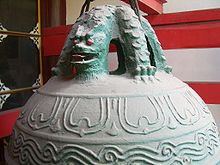 Pulao in Changchun Temple, Wuhan
Pulao in Changchun Temple, Wuhan
Several Ming Dynasty texts list what were claimed as the Nine Offspring of the Dragon (龍生九子), and subsequently these feature prominently in popular Chinese stories and writings. The scholar Xie Zhaozhe (謝肇淛, 1567–1624) in his work Wu Za Zu (五雜俎, ca. 1592) gives the following listing, as rendered by M.W. de Visser:
A well-known work of the end of the sixteenth century, the Wuzazu 五雜俎, informs us about the nine different young of the dragon, whose shapes are used as ornaments according to their nature. The [pulao 蒲牢], dragons which like to cry, are represented on the tops of bells, serving as handles. The [qiuniu 囚牛], which like music, are used to adorn musical instruments. The [chiwen 螭吻/鴟吻], which like swallowing, are placed on both ends of the ridgepoles of roofs (to swallow all evil influences). The [chaofeng 嘲風], lion-like beasts which like precipices, are placed on the four corners of roofs. The [yazi 睚眦/睚眥], which like to kill, serve as ornaments of sword-grips. The [bixi 贔屭], which have the shape of the [chilong 螭龍], and are fond of literature, are represented on the sides of grave-monuments. The [bi'an 狴犴], which like litigation, are placed over prison gates (in order to keep guard). The [suanni 狻猊], which like to sit down, are represented upon the bases of Buddhist idols (under the Buddhas' or Bodhisattvas' feet). The [baxia 霸下], finally, big tortoises which like to carry heavy objects, are placed under grave-monuments. Further, the same author enumerates nine other kinds of dragons, which are represented as ornaments of different objects or buildings according to their liking prisons, water, the rank smell of newly caught fish or newly killed meat, wind and rain, ornaments, smoke, shutting the mouth (used for adorning key-holes), standing on steep places (placed on roofs), and fire.[16]
The Sheng'an waiji (升庵外集) collection by the poet Yang Shen (楊慎, 1488–1559) gives different 5th and 9th names for the dragon's nine children: the taotie (饕餮), which loves to eat and is found on food-related wares, and the jiaotu (椒圖), which looks like a conch or clam, does not like to be disturbed, and is used on the front door or the doorstep. Yang's list is bixi, chiwen or cháofēng, pulao, bi'an, taotie, qiuniu, yazi, suanni, and jiaotu.[17]
Oldest known attestation of the "children of the dragon" list is found in the Shuyuan Zaji (椒园杂记, Miscellaneous records from the bean garden) by Lu Rong (1436–1494); however, he noted that the list enumerates mere synonyms of various antiques, not children of a dragon.[18]
Dragon toes
 The reverse side of a six-lobed bronze mirror from the 8th century, during the Tang Dynasty (618–907), showing a dragon with three toes on each foot
The reverse side of a six-lobed bronze mirror from the 8th century, during the Tang Dynasty (618–907), showing a dragon with three toes on each foot
The first Ming Emperor copied the Yuan ruling and decreed that the dragon would be his emblem and that it would have five toes (or claws) The four-clawed dragon was typically for imperial nobility and certain high ranking officials. The three clawed dragon was used by lower ranks and the general public (widely seen on various Chinese goods in Ming Dynasty). The Long, however, was only for select royalty closely associated with the Imperial family, usually in various symbolic colors, while it was a capital offense for anyone - other than the emperor himself - to ever use the completely gold-colored, five-clawed Long dragon motif. Improper use of claw number and/or colors was considered treason, punishable by execution of the offender's entire clan. Since most East Asian nations at one point or another were considered Chinese tributaries, they were only allowed four-clawed dragons.
The five toes rule was first enforced in AD 1336 (Yuan the second year). "(For commoners) It is forbidden to wear any cloth with patterns of Qilin, Male Fenghuang (Chinese phoenix), White rabbit, Lingzhi, Five-Toe Two-Horn Long, Eight Longs, Nine Longs, 'Ten thousand years', Fortune-longevity character and Golden Yellow etc." ("禁服麒麟、鸾凤、白兔、灵芝、双角五爪龙、八龙、九龙、万寿、福寿字、赭黄等服")[19]
Cultural references
Number nine
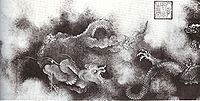 A close up view of one full dragon (and the tail end and claw of another) from the Nine Dragons handscroll painted in AD 1244 by Chen Rong, an artist of the Song Dynasty
A close up view of one full dragon (and the tail end and claw of another) from the Nine Dragons handscroll painted in AD 1244 by Chen Rong, an artist of the Song Dynasty
The number nine is special in China as it is the largest possible single digit, and Chinese dragons are frequently connected with it. For example, a Chinese dragon is normally described in terms of nine attributes and usually has 117 (9x13) scales - 81 (9x9) Yang and 36 (9x4) Yin. This is also why there are nine forms of the dragon and the dragon has nine offspring (see Classical depictions above). The "Nine Dragon Wall" is a screen wall with images of nine different dragons, and is found in imperial Chinese palaces and gardens. As nine was considered the number of the emperor, only the most senior officials were allowed to wear nine dragons on their robes - and then only with the robe completely covered with surcoats. Lower-ranking officials had eight or five dragons on their robes, again covered with surcoats; even the emperor himself wore his dragon robe with one of its nine dragons hidden from view.
There are a number of places in China called "Nine Dragons", the most famous being Kowloon (in Cantonese) in Hong Kong. The part of the Mekong in Vietnam is known as Cửu Long, with the same meaning.
Chinese zodiac
Main article: Dragon (zodiac)The dragon is one of the 12 animals in the Chinese zodiac which is used to designate years in the Chinese calendar. It is thought that each animal is associated with certain personality traits. Dragon years are usually the most popular to have babies. There are more babies born in Dragon years than in any other animal years of the Zodiac.
Constellations
The Azure Dragon - Qing Long - 青龍 is considered to be the primary of the four celestial guardians, the other three being the Zhu Que - 朱雀 (Vermilion Bird), Bai Hu - 白虎 (White Tiger), Xuan Wu - 玄武 (Black Tortoise-like creature). In this context, the Azure Dragon is associated with the East and the element of Wood.
See also: Five elements (Chinese philosophy)Dragonboat racing
- Main article Dragon boat
At special festivals, especially the Duanwu Festival, dragon boat races are an important part of festivities. Typically, these are boats rowed by a team of up to 12 rowers, and with a carved dragon as the head of the boat. Dragon boat racing is also an important part of celebrations outside of China, such as at Chinese New Year.
Dragon dancing
- Main article Dragon dance
On auspicious occasions, including Chinese New Year and the opening of shops and residences, festivities often include dancing with dragon puppets. These are "life sized" cloth-and-wood puppets manipulated by a team of people, supporting the dragon with poles. They perform choreographed moves to the accompaniment of drums and music.
Dragons and Nāgas
In many Buddhist countries, the concept of the nāga has been merged with local traditions of great and wise serpents or dragons, as depicted in this stairway image of a mufti-headed nāga emerging from the mouth of a Makara in the style of a Chinese dragon at Phra Maha Chedi Chai Mongkol on the premises of Wat Pha Namthip Thep Prasit Vararam in Thailand's Roi Et Province Nong Phok District.
Dragons and Tigers
Tigers have always been an eternal rival to the dragon, thus various artworks depict a dragon and tiger fighting an epic battle. A well used Chinese idiom to describe equal rivals (often in sports nowadays) is "Dragon versus Tiger". In Chinese martial arts, "Dragon style" is used to describe styles of fighting based more on understanding movement, while "Tiger style" is based on brute strength and memorization of techniques.[citation needed]
Chinese dragons in popular culture
As a part of traditional folklore, dragons appear in a variety of mythological fiction. In the classical story Journey to the West, the son of the Dragon King of the West was condemned to serve as a horse for the travellers because of his indiscretions at a party in the heavenly court. The Monkey King's cudgel Rú Yì Bàng was stolen from the Eastern (Donghai) Dragon King áo guǎng. In Fengshen Yanyi and other stories, Nezha, the boy hero, defeats the Dragon Kings and tames the seas. Chinese dragons also appear in innumerable Japanese anime movies and TV shows, manga, and in Western political cartoons as a personification of the People's Republic of China. The Chinese respect for dragons is emphasized in Naomi Novik's Temeraire novels, where they were the first people to tame dragons and are treated as equals, intellectuals or even royalty, rather than beasts solely bred for war in the West.
See also
- An Instinct for Dragons, hypothesis about the origin of dragon myths.
- Chinese mythology
- Culture of China
- Dragon
- Dragon boat race
- Dragon dance
- Fenghuang (Mythological bird)
- List of dragons in mythology and folklore
- Long Mu (Dragon's Mother)
- Radical 212
References
- ^ a b c Sleeboom, Margaret. [2004] (2004). Academic Nations in China and Japan: Framed in concepts of Nature, Culture and the Universal. Routledge publishing. ISBN 0-415-31545-X
- ^ "Brand Overview", Brand Hong Kong, 09-2004. Retrieved on 23-02-2007.
- ^ BBC Article: Fiery Debate Over China's Dragon, an article covering China's decision not to use a dragon mascot and the resulting disappointment.
- ^ Robertson, Benjamin (2004-12-17). "The Dragon battles back to beat Nike". Asia Times Online. http://www.atimes.com/atimes/China/FL17Ad01.html. Retrieved 2007-03-20.
- ^ Howard Giskin and Bettye S. Walsh (2001). An introduction to Chinese culture through the family. State University of New York Press. p. 126. ISBN 0791450473.
- ^ Teaching Chinese Archeology, National Gallery of Art, Washington, DC
- ^ Salviati, Filippo (2002). The Language of Adornment: Chinese Ornaments of Jade, Crystal, Amber and Glass, Fig. 17. Ten Speed Press. ISBN 1580085873.
- ^ Dong Zhiming (1992). Dinosaurian Faunas of China. China Ocean Press, Beijing. ISBN 3-540-52084-8. OCLC 26522845.
- ^ "Dinosaur bones 'used as medicine'". BBC News. 2007-07-06. http://news.bbc.co.uk/2/hi/asia-pacific/6276948.stm. Retrieved 2007-07-06.
- ^ Xu and Norell, (2004). "A new troodontid dinosaur from China with avian-like sleeping posture." Nature, 431(7010): 838-841. doi: 10.1038/news041011-7
- ^ de Visser, Marinus Willem (1913), The Dragon in China and Japan, Verhandelingen der Koninklijke akademie van wetenschappen te Amsterdam. Afdeeling Letterkunde. Nieuwe reeks, deel xiii, no. 2, Amsterdam: Johannes Müller, p. 70, http://www.archive.org/details/cu31924021444728 (Also available at University of Georgia Library)
- ^ Doré, Henri. 1917. Researches into Chinese Superstitions. M. Kennelly, D.J. Finn, and L.F. McGreat, trs. T'usewei. Ch'eng-wen reprint 1966, 681.
- ^ "Jade coiled dragon, Hongshan Culture (c. 4700-2920 B.C.)", National Gallery of Art, Washington DC. Retrieved on 23-02-2007.
- ^ Carr, Michael. 1990. "Chinese Dragon Names", Linguistics of the Tibeto-Burman Area 13.2:87-189. He classified them into seven categories: Rain-dragons, Flying-dragons, Snake-dragons, Wug-dragons [wug refers to "worms, bugs, and small reptiles"], Crocodile-dragons, Hill-dragons, and Miscellaneous dragons.
- ^ Adapted from Doré 682.
- ^ de Visser 1913, pp. 101–102. The primary source is Wu Za Zu, chapter 9, beginning with "龍生九子...". The title of Xie Zhaozhe's work, Wu Za Zu, has been variously translated into English as Five Assorted Offerings (in Xie Zhaozhe), Five Sundry Bands (in "Disease and Its Impact on Politics, Diplomacy, and the Military ...") or Five Miscellanies (in Changing clothes in China: fashion, history, nation, p. 48).
- ^ 吾三省 (Wu Sansheng) (2006), 中國文化背景八千詞 (Eight thousand words and expressions viewed against the background of Chinese culture), 商務印書館(香港) (Commercial Press, Hong Kong), p. 345, ISBN 9620718461, http://books.google.com.au/books?id=KQJ_tIU1ixoC&pg=PA345 (Chinese)
- ^ 九、龙的繁衍与附会——龙生九子 (1) ("Chapter 9, Dragon's derived and associated creatures: Nine children of the dragon (1)"), in Yang Jingrong and Liu Zhixiong (2008). The full text of Shuyuan Zaji, from which Yang and Liu quote, is available in electronic format at a number of sites, e.g. here: 菽園雜記
- ^ The Twenty-Four Histories: The History of Yuan-Dress Code (zh:元史·舆服), compiled under Song Lian (宋濂), AD 1370.
External links
- 杨静荣 (Yang Jirong); 刘志雄 (Liu Zhixiong) (2008), 龙之源 (The Origin of the Dragon), 中国书店, ISBN 7806635513, http://vip.book.sina.com.cn/book/catalog.php?book=69989
- Dragon Articles, Crystal Dragon of Taiwan, cdot.org
- Dragons in Ancient China, China the Beautiful, chinapage.com
- Eastern Dragon Overview, The Circle of the Dragon, blackdrago.com
- Forbidden City Dragon Wall panography, world-heritage-tour.org
- The Chinese Dragon, everythingdragons.com
- 龙生九子, The Dragon's 9 Children (Chinese), jsdj.com
- Nine Sons of the Dragon
Chinese mythology Overview topics Major entities Creatures Bixie · Black Tortoise · Azure Dragon · White Tiger · Vermilion Bird · Qilin · Fenghuang · Huli jing · Chinese guardian lions · Píxiū · NiánPlaces Popular literary works Shan Hai Jing · Shi Yi Ji · The Peach Blossom Spring · Fengshen Bang · Legend of the White Snake · Strange Stories from a Chinese Studio · Journey to the West · In Search of the Supernatural · Zi Bu Yu · Tian Xian PeiCategories:- Chinese culture
- Chinese mythology
- Chinese dragons
- Chinese legendary creatures
- National symbols of China
- National personifications
- Dragons
- Asian legendary creatures
Wikimedia Foundation. 2010.

